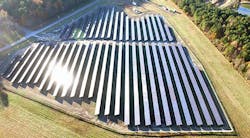Solar array begins operating at University of Maryland Center for Environmental Science
The University of Maryland Center for Environmental Science has flipped the switch on a 10-acre solar field at its Horn Point Laboratory campus in Cambridge, Md.
The center says the 11,000 solar panels that make up the installation are expected to generate the equivalent of 50 percent of the campus’ annual energy consumption.
“The solar field is another example of how we are using innovative ways to reduce our environmental footprint and engage with the community,” says Mike Roman, director of the Horn Point Laboratory, where scientists conduct research in oceanography, water quality, and restoration of seagrasses, marshes and shellfish. “This is a milestone in a long journey to carbon neutrality and non-dependence on fossil fuel."
The university has entered into a Power Purchase Agreement in which Standard Solar Inc. installs and operates the solar panels in exchange for the use of land. The Center for Environmental Science has agreed to purchase from Standard Solar the equivalent energy being generated over the next 20 years.
Standard Solar says the 2 megawatt system has an expected first-year generation exceeding 4,000 megawatt hours of solar energy. That will offset the carbon dioxide emissions from 2,850 pounds of coal burned.
The campus also has installed a solar canopy over a 46-space, crushed stone parking lot that will offset the cost of four level-II electrical vehicle charging stations.
The Center for Environmental Science is a signatory to the American College & University Presidents’ Climate Commitment (Second Nature) and has launched a number programs aimed at reducing its environmental footprint.
It has set goals for reducing Green House Gas emissions at each of its four laboratories, upgraded aging infrastructure with more energy-efficient alternatives, and built all new campus buildings to at least a LEED Silver standard or equivalent.
About the Author
Mike Kennedy
Senior Editor
Mike Kennedy, senior editor, has written for AS&U on a wide range of educational issues since 1999.
